Getúlio Vargas
| His Excellency Getúlio Vargas | |
|---|---|
.jpg) Vargas in 1930 | |
| 14th and 17th President of Brazil | |
|
In office 3 November 1930 – 29 October 1945 | |
| Vice President | None |
| Preceded by | Military Junta of 1930 |
| Succeeded by | José Linhares |
|
In office 31 January 1951 – 24 August 1954 | |
| Vice President | Café Filho |
| Preceded by | Eurico Gaspar Dutra |
| Succeeded by | Café Filho |
| Senator for Rio Grande do Sul | |
|
In office 31 January 1946 – 30 January 1951 | |
| 13th President of Rio Grande do Sul | |
|
In office 25 January 1928 – 8 October 1930 | |
| Vice President | João Neves da Fontoura |
| Preceded by | Borges de Medeiros |
| Succeeded by | Osvaldo Aranha |
| Minister of Finance | |
|
In office 15 November 1926 – 17 December 1927 | |
| President | Washington Luís |
| Preceded by | Aníbal Freire da Fonseca |
| Succeeded by | Oliveira Botelho |
| Federal Deputy for Rio Grande do Sul | |
|
In office 3 May 1923 – 15 November 1926 | |
| State Deputy of Rio Grande do Sul | |
|
In office 20 September 1917 – 3 May 1923 | |
|
In office 20 September 1909 – 20 September 1913 | |
| Personal details | |
| Born |
Getúlio Dornelles Vargas 19 April 1882 São Borja, Rio Grande do Sul, Brazil |
| Died |
24 August 1954 (aged 72) Catete Palace, Rio de Janeiro, Brazil |
| Cause of death | Suicide |
| Resting place | Praça XV de Novembro, São Borja, Rio Grande do Sul, Brazil |
| Nationality | Brazilian |
| Political party |
Rio-Grandense Republican (1909–1930) Independent (1930–1946) Brazilian Labour (1946–1954) |
| Spouse(s) | |
| Children |
Lutero (1912–89) Jandira (1913–80) Alzira (1914–92) Manuel (1916–97) Getúlio Filho (1917–43) |
| Alma mater | Free Faculty of Law of Porto Alegre |
| Signature |
|
| Military service | |
| Allegiance |
|
| Service/branch | Brazilian Army |
| Years of service | 1898–1902 |
| Rank | Corporal |
| Unit | 6th Infantry Battalion |
Getúlio Dornelles Vargas (Portuguese: [ʒeˈtulju doɾˈnɛlis ˈvaɾɡɐs]; 19 April 1882 – 24 August 1954) was a Brazilian lawyer and politician, who served as President during two periods: the first was from 1930–1945, when he served as interim president from 1930–1934, constitutional president from 1934–1937, and dictator from 1937–1945. After being overthrown in a 1945 coup, Vargas returned to power as the democratically elected president in 1951, serving until his suicide in 1954. Vargas led Brazil for 18 years, the longest of any President, and second in Brazilian history only to Emperor Pedro II among heads of state. He favored nationalism, industrialization, centralization, social welfare and populism – for the latter, Vargas won the nickname "The Father of the Poor".[1] Vargas is one of a number of populists who arose during the 1930s in Latin America, including Lazaro Cardenas and Juan Perón, who promoted nationalism and pursued social reform.[2] He was a proponent of workers' rights as well as a staunch anti-communist.
Vargas was brought to power by political outsiders and the rank and file of the Armed Forces in the Revolution of 1930, a reaction to his loss in elections earlier that year. His ascent marked the end of the Brazilian Old Republic and São Paulo-Minas alliance dominated coffee with milk politics. He successfully influenced the outcome of the Brazilian presidential election of 1934, and used fears of a Communist uprising to institute an authoritarian corporatist regime in 1937 known as the New State, modeled off of Mussolini's Italy and Salazar's Portugal. Vargas went on to appease and eventually dominate his supporters, and pushed his political agenda as he built a propaganda machine around his figure.
Vargas sought to transform Brazil from a plantation-based economy into an industrialized powerhouse under the guidance of the government intervention. His embrace of developmentalism was expressed not only in strong rhetoric, but also by lending protection to domestic industries and in a heavy investment budget aimed at kick-starting "strategic" sectors and setting up the necessary infrastructure. Vargas created state monopolies for oil (Petrobras), mining (Vale), steelmaking (National Siderurgy Company), alkalis (National Alkalis Company) and automobiles (National Motors Factory). His policies shaped the Brazilian economic debate for decades, from the governments of Juscelino Kubitschek and leftist João Goulart to the right-wing military dictatorship of 1964 to 1985. The protectionist trend was reversed by the 1990s with the liberal reforms of Fernando Collor de Mello and Fernando Henrique Cardoso.
With the global rise of democracy in the aftermath of World War II, Vargas stepped down in 1945 and was succeeded by José Linhares the same year. Nevertheless, the economic growth that occurred under his administration made him a popular figure in Brazilian politics even after his resignation. His popularity awarded him a late presidential term in 1951, but growing political strife over his views and methods caused Vargas to become stressed, leading to his suicide by gunshot in 1954. He was the first president in the country to draw widespread support from the masses and is regarded as the most influential Brazilian politician of the twentieth century.[3] He had also been a lawyer and landowner who occupied the 37th chair of the Brazilian Academy of Letters from 1943 until his death in 1954.
Background
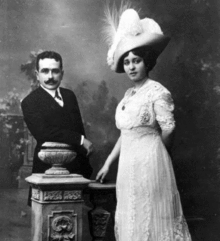
Vargas was born in São Borja, Rio Grande do Sul, southern Brazil, on 19 April 1882, to Manuel do Nascimento Vargas and Cândida Dornelles Vargas. His father had origins in São Paulo, being a descendant of early São Paulo families ("paulistas"): he was a descendant of Amador Bueno, a noted paulista from the colonial Brazilian era.[4] His mother was descended from a wealthy family of Azorean Portuguese descent.[5]
The son of a traditional family of "gaúchos", he embarked on a military career. Vargas enlisted as a private in 1899 in the sixth infantry battalion and later joined the military college at Rio Pardo. Vargas then turned to law school at Porto Alegre in the Rio Grande, and while there he published a political newspaper, O Debate. Vargas was the chosen orator in his graduating class of 1907 and was immediately appointed district attorney. In 1909 he opened his own law office in São Borja.[6] Entering Republican politics, he was elected to the Legislative Assembly of Rio Grande do Sul and later to the federal Chamber of Deputies in 1922, where he became the floor leader for his state's delegation in Congress. He served as Finance Minister from 1926 to 1928 under President Washington Luís, from which post he resigned to enter the gubernatorial race in his home state. Once elected Governor of Rio Grande do Sul, he became a leading figure in the national opposition, urging the end of electoral corruption through the adoption of the universal and secret ballot. As Governor of Rio Grande do Sul he distinguished himself as an excellent administrator. During his term as governor he reorganized the agricultural system. He established a state mortgage and agricultural bank. He also created the department of agriculture in his state. Vargas also worked hard to improve schools and infrastructure during his term as governor.[7]
He and his wife Darci Lima Sarmanho, whom he married in March 1911, had five children: Lutero, Alzira, Jandira, Manuel e Getulinho. According to legend, Vargas' real love was not his wife, but Aimee de Sa Sottomaior,[8] later Aimée de Heeren, recognized by the international fashion press as one of the world's most glamorous and beautiful women. The relationship was a Brazilian state secret, although Vargas did mention her in a diary published after the death of his wife. Aimee de Herren, later living between France and the United States and admired by other famous statesmen such as the Kennedy brothers, never confirmed nor denied the rumor.[9]
National Politics
Between the two World Wars, Brazil was a rapidly industrializing nation popularly regarded as "the sleeping giant of the Americas" and a potential world power. However, the oligarchic and decentralized confederation of the Old Republic, dominated by landed interests, in effect showed little concern for promoting industrialization, urbanization, and other broad interests of the new middle class. The coffee planters of São Paulo, in particular, were content with exporting their product abroad while relying on foreign investment to build the economy.[10] In addition, they feared reforms that might lead to radical social change. Through the agreements of café com leite, São Paulo and their junior partner, Minas Gerais, rotated the presidency and dominated national politics, securing political stability and the economic success of the upper classes. However, resentment had grown among the middle class, who shared the landowners' fears of radical social change, but who wanted to invest in industrialization and restrict foreign investment.[11] In 1926, Washingtion Luis, a native of Macaé a city of Rio de Janeiro but he ran for São Paulo, was elected president. His election had been assisted by the political machine of Borges de Medeiros, and so he nominated one of that machine's members, Getulio Vargas, to be his Finance Secretary. Although Vargas was only to serve two years as Finance Secretary before returning to Rio Grande do Sul to become governor, he gained valuable recognition and experience on the national level.[12]
Vargas and the Revolution of 1930
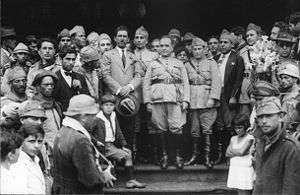
The Great Depression set off the tensions that had been building in Brazilian society for some time, spurring revolutionary leaders to action. The elections of 1930 pitted Júlio Prestes of the establishment, São Paulo-faction, against Vargas, who led a broad coalition of middle-class industrialists, planters from outside São Paulo, and the reformist faction of the military known as the tenentes.[13] The middle class resented free market and café com leite policies that let foreign companies out compete them and restricted industrialization.[14] The non-São Paulo landowners feared radical change and had no desire for the economic nationalism advocated by the bourgeoisie, but did want to end the dominance of São Paulo.[15] The tenentes had been led through the Brazilian countryside by Luis Carlos Prestes to rally support for a military coup, and though they failed to find support, they had become exposed to rural poverty and now favored social reform.[16] Together, these disparate groups made up the Liberal Alliance. Support was especially strong in the southern provinces of Minas Gerais, Paraíba and Rio Grande do Sul, because in nominating another Paulista to succeed himself, Washington Luis had violated the traditional alteration between Minas Gerais and São Paulo.[17] Vargas campaigned carefully, needing to please a large range of supporters. He used populist rhetoric and promoted bourgeois concerns. He opposed the primacy of São Paulo, but did not challenge the planters' legitimacy and kept his calls for social reform moderate. The election itself was plagued by corruption and denounced by both sides, and when it had become clear that the São Paulo candidate, Júlio Prestes, had won the election, tensions were high. When the vice-presidential candidate of the Liberal Alliance was assassinated, the military decided to initiate a bloodless coup. On October 24, 1930, they ousted President Washington Luís and the president-elect Júlio Prestes, installing Vargas as 'interim president'.[18]
Interim President
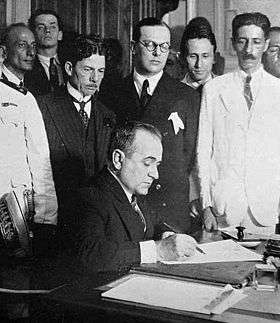

Vargas was a wealthy pro-industrial nationalist and anti-communist who favoured corporatism. Although he had been careful not to offend the landowners during the campaign, he did advocate moderate social reform and economic nationalism.[19] He began by addressing the crisis in the coffee industry, which was suffering from low prices due to the Great Depression. Vargas implemented the traditional solution of valorization, in which the state bought up extra coffee supplies. In addition, Vargas promoted the diversification of agriculture, especially with cotton.[20]
Like FDR in the U.S., Vargas employed economic stimulus. A state interventionist policy utilizing tax breaks, lowered duties, and import quotas[21] allowed Vargas to expand the domestic industrial base. Vargas linked his pro-industrial policies to nationalism, advocating heavy tariffs[22] to "protect our manufacturers to the point where it will become unpatriotic to feed or clothe ourselves with imported goods." Vargas quelled a female workers' strike in São Paulo by co-opting much of their platform but requiring their "factory commissions" to use government mediation in the future.[23] Vargas, reflecting the influence of the tenentes, even advocated a program of social welfare and reform similar to the New Deal. One of Vargas' first acts in a pattern of Populist gestures was the promotion of Pedro Ernesto Baptista's candidacy for mayor of Rio de Janeiro. He also introduced voting reforms for the election of the constituent assembly that would draft the 1934 constitution, including a secret ballot, votes for women, and a voting age of eighteen instead of twenty-one.[24]
Opposition to Vargas was radicalised in the 1932 movement that was aimed at the restoration of democracy and the establishment of a new constitution. The revolt was beaten back, but a new constitution was written in 1934. After that, Vargas seized absolute power and controlled dissidents through press and mail censorship. His tenuous coalition also lacked a coherent program, being committed to a broad vision of modernization, but little more specific. Vargas, especially during his early years, was always in danger of being ousted by one or more of the groups in his coalition, including the anti-São Paulo planters, the bourgeoisie, and the military.[25]
Constitution of 1934 and Vargas' Early Presidency
The parallels between Vargas and the European police states began to appear by 1934, when a new constitution was enacted with some direct almost-fascist influences.
Brazil's 1934 constitution, passed on 16 July, contained provisions that resembled Italian and Spanish corporatism, which had the enthusiastic support of the pro-fascist wing of the disparate tenente movement and industrialists, who were attracted to Mussolini's co-optation of unions through state-run, sham syndicates. As in Italy, and later Spain and Germany, Fascist-style programs would serve two important aims, stimulating industrial growth and suppressing the communist influence in the country. Its stated purpose, however, was uniting all classes in mutual interests. The constitution established a new Chamber of Deputies that placed government authority over the private economy, which established a system of state-guided capitalism aimed at industrialization and reducing foreign dependency. "Progressive nationalization" would be used to bring natural resources under state control, and the government would have the right to set minimum wages, mediate in strikes, and enact labor legislation. Nonetheless, a significant amount of political power was still preserved for the states and the federalism of the Old Republic continued.
After 1934, the regime designated corporate representatives according to class and profession, but maintained private ownership of Brazilian-owned business. Based on increased labor rights and social investment, Brazilian corporatism was actually a strategy to increase industrial output utilizing a strong nationalist appeal. Vargas, and later Juan Perón in neighboring Argentina, emulated some of Mussolini's strategy of mediating class disputes and co-opting workers' demands under the banner of nationalism. Under the increase of workers' rights also, Vargas greatly expanded labor regulations with the consent of industry, pacified by strong industrial growth. The working day was set at eight hours in commerce and industry, minimum wages were established nationwide, and benefits programs such as pensions and paid vacations were guaranteed.
Despite the material gains of labor, Vargas began slowly shifting to the right. Reforms were not extended to cover the 85% of workers in the agricultural sector, and little effort was made even to enforce the minimum wage in rural areas. Meanwhile, the president came into increasing conflict with Luis Carlos Prestes, the former leader of the tenentes who was now in charge of the Brazilian Communist Party. Prestes was also in charge of the National Liberation Alliance (ANL), which was banned in 1935 after Prestes criticized Vargas. A rebellion of the ANL and Communists in 1935 gave Vargas the excuse he needed to consolidate his power.
New State and Suppression of Integralism
.jpg)
Vargas faced having to step down as president in 1938 because his own 1934 constitution prohibited the president from succeeding himself. On 29 September 1937, Gen. Dutra, his rightist collaborator, revealed "the Cohen Plan", which detailed a plan for a Communist revolution. He publicly demanded that the government declare a state of siege. On 10 November 1937, Vargas announced in a nationwide radio address that he was seizing emergency powers. He also dissolved Congress and canceled the elections due for January 1938. On the same night, the constitution was recast into a severely authoritarian document that concentrated virtually all power in Vargas' hands. The regime created by this document is known as the Estado Novo (New State). The short interval strongly suggests that the self-coup had been planned well in advance.
Under the Estado Novo, Vargas abolished political parties, imposed censorship, established a centralized police force, and filled prisons with political dissidents, while evoking a sense of nationalism that transcended class and bound the masses to the state. He ended up repressing his erstwhile supporters, the "Integralists," as well, once the communists were already defeated. The Integralists wished for a total fascist dictatorship, which was more than he desired.
During the Estado Novo Vargas made major changes to the Brazilian economy for the betterment of Brazil. But also with help and pressure from the United States, because of the second World War. Vargas began to prioritize the middle class and provided for higher education and better job opportunities. Vargas also began to focus on industrialization; this led to the creation of the first steel mill in Brazil at Volta Redonda. To help further modernize and industrialize Brazil Vargas nationalized oil production and refinement. To improve the life of the laborer Vargas implemented the forty hour work week, a minimum wage, and other regulations to protect middle class and poorer workers.[26]
The 1937 Constitution provided for elections to a new Congress, as well as a referendum to confirm Vargas' actions. However, neither were held — ostensibly due to the dangerous international situation. Instead, under an article of the Constitution that was supposed to be transitional pending new elections, Vargas assumed legislative as well as executive powers. Also, under the 1937 Constitution Vargas should have remained President for only six more years (until November 1943), but instead stayed in office until 1945. For all intents and purposes, Vargas ruled for eight years under what amounted to martial law.
Vargas and the Axis Powers
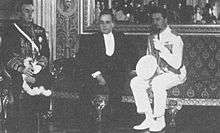

Vargas employed ambiguous policies towards Axis and Allied orbits. At first, Brazil seemed to be entering the Axis orbit — even before the 1937 declaration of the Estado Novo. Between 1933 and 1938, Germany became the main market for Brazilian cotton, and its second largest importer of Brazilian coffee and cacao. The German Bank for South America even established three hundred branches in Vargas' Brazil.
The rapid increase in civilian and military trade between Brazil and Nazi Germany gave US officials reason to begin wondering about Vargas' international alignment.
The repressions that followed the communist's coup d'état attempt in Brazil in November 1935 increased the cooperation between Brazil and Germany. After Brazil deported the revolutionary Jewish German Olga Benário Prestes, wife of Luís Carlos Prestes to Germany in 1937, Brazil was invited to be part of the Axis Powers at the side of Japan, Italy and Germany. However, when Brazil refused this invitation at the advent of the "Estado Novo" at the end of that same year, the relations between Brazil and the countries of the Axis started to chill.
This estrangement also occurred in part due to the German-Italian-Japanese powers becoming frustrated in regards to what they believed the Estado Novo should represent. The policy of forced assimilation and nationalization imposed by Vargas and the military over every immigrant community, including the German, Italian, Spanish and Japanese ones, as well as the prohibition of any political activities that were not directly endorsed by the central power in Rio de Janeiro, which included the Nazi Party in Brazil and its allies, the Brazilian Integralists, motivated Italian-Spanish-German support of the Integralists' coup d'état attempt in May 1938. The failure of that action and the British naval blockade on the trade of Germany, Italy and Spain on the Atlantic, especially from 1940 onwards, led to a sharp deterioration of relations between Brazil and the Axis powers.[27]
World War II and the fall of the New State
From 1940, the US started to reach out to Brazilians with its "Good Neighbor Policy". The US also granted large loans to Brazil, which Vargas used to industrialize the country. Vargas, always a shrewd, low-key, and reasoned pragmatist, sided with the anti-fascist Allies for economic reasons after a period of ambiguity, since the Allies were more viable trading partners and helped with money. However, he and the military were slowly forced to liberalize the regime because of complications arising from this alliance. In siding with the Allies, one agreement that Vargas made was to help the Allies with rubber production in order to receive loans and credit from the US. In reprisal for breaking off diplomatic relations in January 1942, and assigning air bases to Americans in the north of Brazil, Hitler ordered the extension of the Axis naval offensive over the South Atlantic. After Brazil's merchant ships were sunk by German and Italian submarines, at the cost of hundreds of civilian deaths, Brazil sided with the Allies, declared war on Germany and Italy on 22 August 1942 and eventually sent an expeditionary force to fight in the Italian Front in the second half of 1944.
This siding with the anti-fascist Allies created a paradox at home not unnoticed by Brazil's middle class — an authoritarian regime, still with some fascistic overtones, joining forces with the anti-fascist Allies. This increased the anti-dictatorship sentiment at home even more. Vargas astutely responded to the newly liberal sentiments of a middle class that was no longer fearful of disorder and proletarian discontent by moving away from repression. He promised "a new postwar era of liberty" that included amnesty for political prisoners, presidential elections, and the legalization of opposition parties, including the moderated and irreparably weakened Communist Party. The forces released by this political liberalization severely weakened the Estado Novo and was substantial enough to prompt his own war ministry to force Vargas' resignation on 29 October 1945. Democracy returned a few months later with the 1945 presidential election.
Labor legislation
Despite the passage of many labor laws that significantly improved the lives of laborers (such as paid vacation, minimum wage, and maternity leave), there were still many shortcomings in the enforcement and implementation of labor legislation.[28] While it was impossible for the minimum wage laws to be evaded by large businesses or in large towns,[29] the minimum rural salary of 1943 was, in many cases, simply not abided by employers.[30] In fact, many social policies never extended to rural areas.[31] While each state varied, social legislation was enforced less by the government and more by the good will of employers and officials in the remote regions of Brazil.[32] Vargas' legislation did more for the industrial workers than for the more numerous agricultural workers,[33] despite the fact that only relatively few industrial workers joined the unions that the government encouraged.[34] The state-run social security system was inefficient and the Institute for Retirement and Social Welfare produced few results.[35] The popular backlash due to these shortcomings was evidenced by the rising popularity of the National Liberation Alliance.[36]
Second presidency
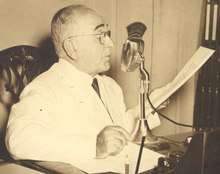
When he left the Estado Novo presidency, the economic surplus of Brazil was high and the industry was growing. After four years, however, pro-US President Eurico Dutra wasted huge quantities of money protecting foreign, mostly US, industry, and distanced himself from the ideas of nationalism and modernization of the country championed by Vargas. Vargas returned to politics in 1951 and through a free and secret ballot was re-elected President of the Republic. Hampered by the economic crisis largely engendered by the policies of Dutra, Vargas pursued a nationalist policy, turning to the country's natural resources and away from foreign dependency. As part of this policy, he founded Petrobrás (Brazilian Petroleum), a large, multinational petroleum concern largely owned by the Government of Brazil.
Death
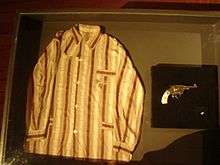
Vargas' political adversaries initiated a crisis which culminated in the "Rua Tonelero" incident, where Major Rubens Vaz was killed during an attempt on the life of Vargas' main adversary, Carlos Lacerda. Lieutenant Gregório Fortunato, chief of Vargas' personal guard, also called "Black Angel", was accused of masterminding the assassination attempt. This aroused a reaction in the military against Vargas and the generals demanded his resignation. In a last-ditch effort Vargas called a special cabinet meeting on the eve of August 24, but rumors spread that the armed forces officers were implacable.
Having lost control of the situation, Vargas shot himself in the chest on August 24, 1954, in the Catete Palace with a Colt Police Positive Special.[37]
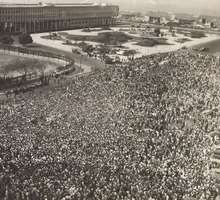
Vargas' suicide note was found and read on the radio two hours after his son discovered the body. The famous last lines read, "Serenely, I take my first step on the road to eternity. I leave life to enter history."[38] Vargas' suicide has been interpreted in various ways. "His death by suicide simultaneously traded on the image of a valiant warrior selflessly fighting for the protection of national interests, alongside the image of a crafty and calculating statesman, whose political machinations reeked of demagoguery and self-interest."[39] Riots broke out in Rio de Janeiro and Porto Alegre on August 24, 1954.[40]
The Vargas family refused a state funeral, but his successor João Café Filho declared official days of mourning.[41] Vargas' body was on public view in a glass-topped coffin. The route of the cortege carrying the body from the Presidential Palace to the airport was lined with tens of thousands of Brazilians. The burial and memorial service were in his hometown of São Borja, Rio Grande do Sul.[42]
The Museu Histórico Nacional was given the furnishings of the bedroom where Vargas committed suicide, and a museum gallery recreates the scene and is a site of remembrance.[43] On exhibit in the Palace is his nightshirt with a bullet hole in the chest. The popular outrage that his suicide caused had supposedly been so strong that it thwarted the ambitions of his enemies, among them rightists, anti-nationalists, and pro-United States elements, for several years.
Getúlio Dornelles Vargas is buried in his native São Borja in Rio Grande do Sul.
See also
References
- ↑ Poppino, Rollie E. "Getúlio Vargas: President of Brazil". Encyclopædia Britannica. Retrieved 7 March 2017.
- ↑ Benajmin, Keen; Keith, Haynes (2004). A History of Latin America (Seventh ed.). New York: Houghton Mifflin. pp. 300–303, 329–334, 364–376. ISBN 0-618-31851-8.
- ↑ Hassan Arvin-Rad, Maria José Willumsen, Ann Dryden Witte. (in portuguese)Industrialização e Desenvolvimento no Governo Vargas: Uma Análise Empírica de Mudanças Estruturais. Universidade de São Paulo. Estudos Econômicos, Vol 27 No 1.
- ↑ "Getulio Vargas". Retrieved 20 January 2015.
- ↑ KOIFMAN, Fábio. Presidentes Do Brasil: De Deodoro A Fhc.
- ↑ Lillian Fisher "Getulio Vargas, The Strong Man of Brazil" International Honors Society of Social Sciences Vol. 19 No. 2 Pg. 80-86 April, 1944
- ↑ Lillian Fisher "Getulio Vargas, The Strong Man of Brazil" International Honors Society of Social Sciences Vol. 19 No. 2 Pg. 80-86 April, 1944
- ↑ "From the invention of the Phone to the Internet White Pages". Retrieved 20 January 2015.
- ↑ "Aimee de Heeren.com - one of the most glamorous Woman of the 20th century". Archived from the original on 10 January 2015. Retrieved 20 January 2015.
- ↑ Benajmin, Keen; Keith, Haynes (2004). A History of Latin America (Seventh ed.). New York: Houghton Mifflin. pp. 364–376. ISBN 0-618-31851-8.
- ↑ Benajmin, Keen; Keith, Haynes (2004). A History of Latin America (Seventh ed.). New York: Houghton Mifflin. pp. 364–376. ISBN 0-618-31851-8.
- ↑ Watkins, Thayer. "Getulio Vargas and the Estado Novo". San José State University Department of Economics. Retrieved 7 March 2017.
- ↑ Benajmin, Keen; Keith, Haynes (2004). A History of Latin America (Seventh ed.). New York: Houghton Mifflin. pp. 364–376. ISBN 0-618-31851-8.
- ↑ Benajmin, Keen; Keith, Haynes (2004). A History of Latin America (Seventh ed.). New York: Houghton Mifflin. pp. 364–376. ISBN 0-618-31851-8.
- ↑ Benajmin, Keen; Keith, Haynes (2004). A History of Latin America (Seventh ed.). New York: Houghton Mifflin. pp. 364–376. ISBN 0-618-31851-8.
- ↑ Benajmin, Keen; Keith, Haynes (2004). A History of Latin America (Seventh ed.). New York: Houghton Mifflin. pp. 364–376. ISBN 0-618-31851-8.
- ↑ Watkins, Thayer. "Getulio Vargas and the Estado Novo". San José State University Department of Economics. Retrieved 7 March 2017.
- ↑ Benajmin, Keen; Keith, Haynes (2004). A History of Latin America (Seventh ed.). New York: Houghton Mifflin. pp. 364–376. ISBN 0-618-31851-8.
- ↑ Benajmin, Keen; Keith, Haynes (2004). A History of Latin America (Seventh ed.). New York: Houghton Mifflin. pp. 300–303, 329–334, 364–376. ISBN 0-618-31851-8.
- ↑ Benajmin, Keen; Keith, Haynes (2004). A History of Latin America (Seventh ed.). New York: Houghton Mifflin. pp. 300–303, 329–334, 364–376. ISBN 0-618-31851-8.
- ↑ Benajmin, Keen; Keith, Haynes (2004). A History of Latin America (Seventh ed.). New York: Houghton Mifflin. pp. 370–171. ISBN 0-618-31851-8.
- ↑ Benajmin, Keen; Keith, Haynes (2004). A History of Latin America (Seventh ed.). New York: Houghton Mifflin. pp. 364–376. ISBN 0-618-31851-8.
- ↑ Benajmin, Keen; Keith, Haynes (2004). A History of Latin America (Seventh ed.). New York: Houghton Mifflin. pp. 370–171. ISBN 0-618-31851-8.
- ↑ Benajmin, Keen; Keith, Haynes (2004). A History of Latin America (Seventh ed.). New York: Houghton Mifflin. p. 372. ISBN 0-618-31851-8.
- ↑ Benajmin, Keen; Keith, Haynes (2004). A History of Latin America (Seventh ed.). New York: Houghton Mifflin. pp. 364–376. ISBN 0-618-31851-8.
- ↑ Roett, Riordan (2011). The New Brazil. Brookings Institution Press. pp. 42–43.
- ↑ Dennison de Oliveira, "Os soldados alemães de Vargas" Portuguese [Germans against Hitler; "The German soldiers of Vargas" ] 1st Chapter, Jurua print. 2008 ISBN 85-362-2076-7
- ↑ Loewenstein, Karl. Brazil Under Vargas. New York: Russell & Russell, 1973. Pg 348
- ↑ Loewenstein, Karl. Brazil Under Vargas. New York: Russell & Russell, 1973. Pg 347
- ↑ Bourne, Richard. Getulio Vargas of Brazil, 1883–1954 Sphinx of the Pampas. London: C. Knight, 1974. Pg 155
- ↑ Levine, Robert M. Brazilian Legacies. Armonk, New York: M.E. Sharpe, 1997. Pg 47
- ↑ Loewenstein, Karl. Brazil Under Vargas. New York: Russell & Russell, 1973. Pg 351
- ↑ Bourne, Richard. Getulio Vargas of Brazil, 1883–1954 Sphinx of the Pampas. London: C. Knight, 1974. Pg 198
- ↑ Levine, Robert M. Father of the Poor?: Vargas and His Era. New York: Cambridge UP, 1998. Pg 67
- ↑ Levine, Robert M. Brazilian Legacies. Armonk, NY: M.E. Sharpe, 1997. Pgs 186, 47
- ↑ Bourne, Richard. Getulio Vargas of Brazil, 1883–1954 Sphinx of the Pampas. London: C. Knight, 1974. Pg 70
- ↑ "1954: Brazilian president found dead". British Broadcasting Corporation. 1954. Retrieved 19 April 2009.
- ↑ "Brazilian president found dead". BBC. Retrieved 20 January 2015.
- ↑ Daryle Williams and Barbara Weinstein, "Vargas Morto: The Death and Life of a Brazilian Statesman," in Death, Dismemberment, and Memory: Body Politics in Latin America, edited by Lyman L. Johnson. Albuquerque: University of New Mexico Press 2004, p. 275.
- ↑ Williams and Weinstein, "Vargas Morto", photo, p. 295
- ↑ Williams and Weinstein, "Vargas Morto", pp. 285-87.
- ↑ Williams and Weinstein, "Vargas Morto" pp. 287-94.
- ↑ Williams and Weinstein, "Vargas Morto", pp. 299-301
Further reading
- French, John D. "The Populist Gamble of Gétulio Vargas in 1945: Political and Ideological Transitions in Brazil," in Latin America in the 1940s, David Rock, ed. Berkeley and Los Angeles: University of California Press 1994, pp. 141-165.
- Jens R Hentschke, Estado Novo (Saarbrücken: Verlag für Entwicklungspolitik, 1996), 725 pp.
- Jens R Hentschke, Positivism gaúcho-Style: Júlio de Castilhos's Dictatorship and Its Impact on State- and Nation-Building in Vargas' Brazil (Berlin: Verlag für Wissenschaft und Forschung, 2004), x, 135 pp (edição brasileira, por EdiPUCRS, em 2015)
- Jens R Hentschke (ed.), Vargas and Brazil: New Perspectives (New York: Palgrave Macmillan, 2006), 308 pp.
- Jens R Hentschke, Reconstructing the Brazilian Nation: Public Schooling in the Vargas Era (Baden-Baden: Nomos, 2007), 518 pp.
- Robert M. Levine, Father of the Poor?: Vargas and His Era (Cambridge University Press, 1998).
- Samuel Putnam, "Vargas Dictatorship in Brazil," Science and Society, vol. 5, no. 2 (Spring 1941), pp. 97–116. In JSTOR.
- Thomas E. Skidmore, Politics in Brazil: An Experiment in Democracy, 1930-1964. Oxford: Oxford University Press 1967.
- Barbara Weinstein, "Getúlio Vargas, Diario, 1937/1942". Luso-Brazilian Review 34, no. 2 (winter 1997), 137-41.
- Daryle Williams, Culture Wars in Brazil: The First Vargas Regime, 1930-1945. Durham: Duke University Press 2001.
- Daryle Williams and Barbara Weinstein, "Vargas Morto: The Death and Life of a Brazilian Statesman," in Death, Dismemberment, and Memory: Body Politics in Latin America, Lyman L. Johnson, editor. Albuquerque: University of New Mexico Press 2004, pp. 273–315.
External links
| Wikimedia Commons has media related to Getúlio Vargas. |
- BBC On This Day 24 August – 1954: Brazilian president found dead
- Getúlio Vargas at Find a Grave
- Getulio Vargas and Estado Novo
- Newspaper clippings about Getúlio Vargas in the 20th Century Press Archives of the German National Library of Economics (ZBW)
| Academic offices | ||
|---|---|---|
| Preceded by Alcântara Machado |
3rd Academic of the 37th chair of the Brazilian Academy of Letters 29 December 1943 – 24 August 1954 |
Succeeded by Assis Chateaubriand |
| Political offices | ||
| Preceded by Borges de Medeiros |
President of Rio Grande do Sul 1928–1930 |
Succeeded by Osvaldo Aranha |
| Preceded by Washington Luís |
President of Brazil 1930–1945 |
Succeeded by José Linhares |
| Preceded by Brazilian Military Junta of 1930 |
Head of State and Government of Brazil 1930–1945 |
Succeeded by José Linhares |
| Preceded by Eurico Gaspar Dutra |
President of Brazil 1951–1954 |
Succeeded by Café Filho |
